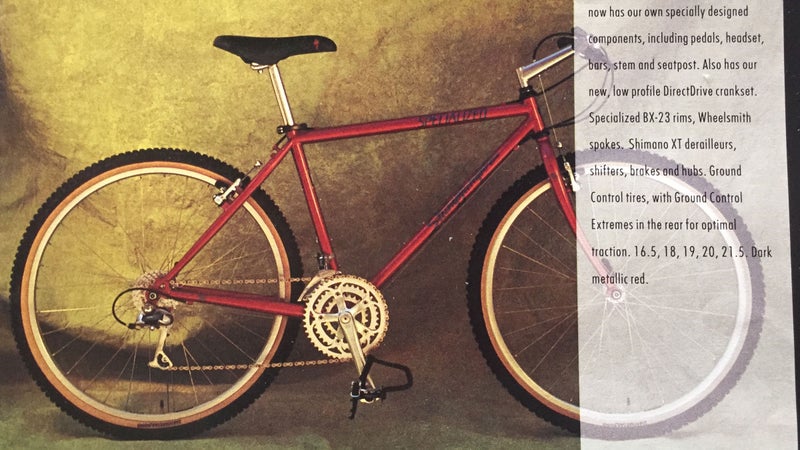In the early 1990s, I worked at a ski and bike shop and waitressed in Avon, Colorado. I spent the rest of my waking hours in the mountains, occasionally┬ádreaming up stupid human tricks, like the time four gear-shop buddies and I drove to the top of Loveland Pass and launched what we liked to think of as ÔÇťbig airÔÇŁ from a backcountry ski jump under a full moon. Winter turned to summer and, since I worked at a gear store, that meant time for new toys:┬áI upgraded my circa-1988┬áSpecialized Rock Hopper to a 1992 Stumpjumper Comp. With Shimano XT derailleurs, shifters, brakes, and┬áhubs┬áand 26-inch wheels sheathed in nubby 1.95-inch Ground Control tires,┬áthere was nothing this 28-pound┬árigid steel behemoth couldnÔÇÖt handle. The frame was deep metallic red,┬ábut it looked more like hot-berry pink,┬áa funny irony considering todayÔÇÖs contempt for the shrinking and pinking┬áof womenÔÇÖs gear. Back then, there was no womenÔÇÖs gear, and I didnÔÇÖt care. I just loved the way the bike embodied the freedom I felt that summer.

Twenty-six years later, SpecializedÔÇÖs new ($4,200;┬áalloy starts at $1,850) elicits the same joy, albeit with 150 millimeters┬áof travel in the front Fox Float Rhythm 34 fork. The blazing headline about the 2018 Stumpjumper, which comes in┬áeither short or┬álong travel as well as 27.5- and 29-inch wheel sizes, is that Specialized overhauled it with an asymmetric frame. The redesign┬ámakes┬áit 20 percent stiffer┬áwhile reducing the weight by 110 to 550 grams, depending on the model,┬ámaking┬áthe bike faster and less like a pogo stick, a criticism that bikes with this much travel tend to earn. ItÔÇÖs also longer as well as slacker in the front, which translates to a flowing, precision ride on downhills. And┬áto throw in another evolutionary curveball, the bike has , which allows for varying-width tires, and┬áon the 29er version┬áriders can swap in 27.5-inch wheels with the assistance of┬áa ÔÇťflip chipÔÇŁ┬ádesigned into the rear suspension linkage that raises the bottom bracket six millimeters. This essentially gives the rider two bikes in one because the size of the wheel changes the dynamics of the rideÔÇöfrom cornering to obstacle clearance to downhill speed. (Note that the 27.5 version, however, cannot run 29er wheels.)
Specialized also improved the internal cable routing,┬áadded a threaded bottom bracket,┬áand made it all compatible with any metric shock, changes that make the bike easier to repair and upgrade with non-proprietary parts. And finally, to quiet the ride, it added a chainstay protector that looks like a modernist, molded wave sculpture. In short, itÔÇÖs a substantial overhaul.
As is the case with most Specialized mountain bikes, the frame size is unisexÔÇöa five-foot-nine guy would ride the same size-medium frame as a five-foot-nine womanÔÇöbut the offers features┬álike optional shorter cranks,┬ánarrower handlebars,┬áa womenÔÇÖs saddle that adds comfort and┬ástrength┬áand reduces pressure points,┬áand rear suspension attuned to womenÔÇÖs weight ranges and riding styles. The bike is also gorgeous: sleek black with┬áan orange and hot-pink ÔÇťSpecializedÔÇŁ blazing along the underside of the down tube.

Until I tested the new Stumpjumper, I had never ridden a womenÔÇÖs┬ámountain bike. IÔÇÖm not opposed to them, but at five foot ten┬áI felt too tall to fit a womenÔÇÖs frame, which has historically been smaller than a menÔÇÖs frame. Currently I ride the menÔÇÖs version of the , the Cadillac of mountain bikes, which elegantly steamrolls singletrack┬áfrom the sharp red rocks of Sedona, Arizona, to the technical, rolling berms, roots, and rocks of Duluth, Minnesota, where I live.
If the Camber 29er is like a turbocharged Cadillac Coupe, the 27.5 Stumpjumper Comp is like a Porsche 911 Carrera: playful, aggressive, and power-packed. ItÔÇÖs impossible not to have a blast on this bike, especially going downhill. What struck me the most is how fast and smooth it is on tight┬ácurves. The StumpjumperÔÇÖs slacker front wheel angle and the faster acceleration of 27.5-inch wheels┬ámake going downhill less a physics project to master and more brainless fun.
Despite the StumpyÔÇÖs ease on the downhills, the bike and I still have a few kinks to work out. On the uphills it felt slightly heavier and less efficient than┬ámy Camber, an issue that might be overcome by buying carbon rims or riding tires less aggressive than the 2.6-inch front Butcher and back Purgatory models that come with the bike. The other bummer: on the most technical uphill trail sections, I struck my pedals on rocks and roots more often than I did on the same sections while riding the Camber. ThatÔÇÖs likely a result of the StumpjumperÔÇÖs having roughly 25 millimeters more travel in the rear Fox DPS Performance shock than IÔÇÖm used to. However, it could also be user error, a function of┬áhaving to learn┬áhow to properly ratchet while riding 27.5-inch wheels.
After nearly a month of riding variable trails daily on the new Stumpjumper, it renewed my passion for SpecializedÔÇÖs legacy bike, one that has been in its lineup since 1981. It also made me appreciate the companyÔÇÖs dedication to the evolution of mountain biking. Without its innovation, my life, for one, would be a lot less fun.


